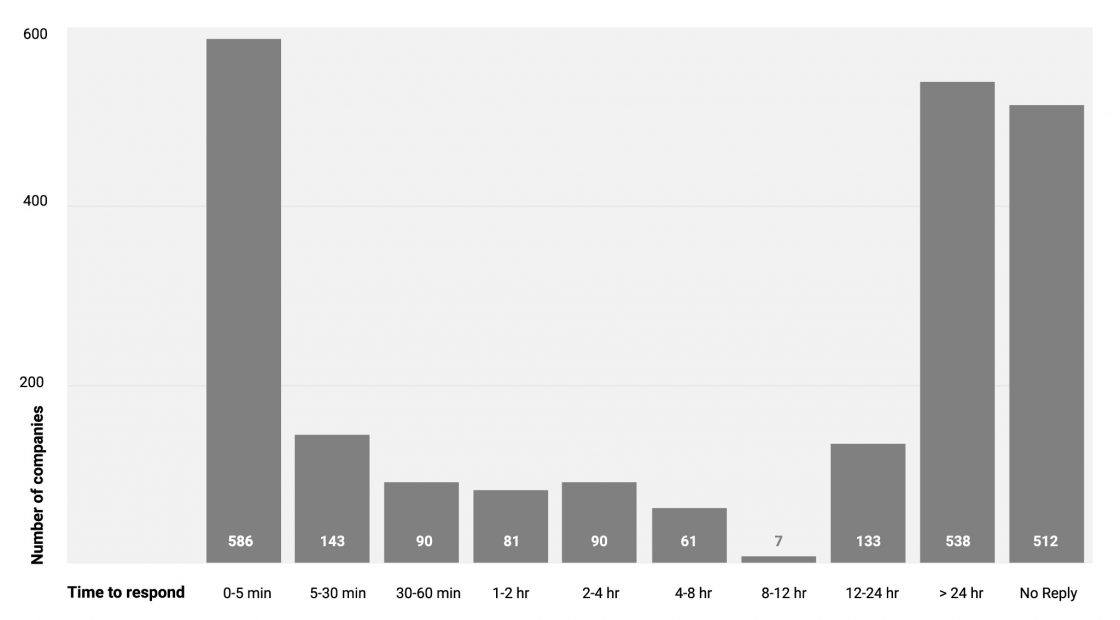Everyone wants a steady stream of leads, and with the right marketing, you’ll get them. But then what? It can be tough to know what it takes to turn those leads into paying customers. We’re here to help. At Etna, we’re fortunate to work closely with the top players in the medical marketing space. We consulted with 6 industry experts to get their takes on how you can turn (almost) every lead into a patient.
Our Panel of Industry Experts

Karen Zupko
President
Karen Zupko & Associates, Inc.

Sandy Roos
VP Business Development & Marketing
North Texas Plastic Surgery

Catherine Maley
President
Cosmetic Image Marketing

Marie Olesen
Founder & Chief Patient Experience Officer
Vizium360 creators of RealPatientRatings

Enrique Rangel
CEO
MyMedLeads
1. Recognize the Need for Speed
Our first expert, Karen Zupko, President of the medical practice management consulting firm Karen Zupko & Associates, Inc., points to The Short Life of Online Sales Leads published in the Harvard Business Review. This article covers research that audited more than 2,000 U.S. companies to measure how long each took to respond to a web-generated lead (see chart). They found that 37% responded within an hour and 16% within 1 to 24 hours. But 24% took more than 24 hours, and 23% never responded at all!

The article states, “These results are especially shocking given how quickly online leads go cold—a phenomenon we explored in a separate study, which involved 1.25 million sales leads received by 29 B2C and 13 B2B companies in the United States. Firms that tried to contact potential customers within an hour of receiving a query were nearly 7 times as likely to qualify the lead than those that tried to contact the customer even an hour later—and more than 60 times as likely as companies that waited 24 hours or longer.”
Zupko goes on, “There’s an old saying that Staff Respects, What Management Inspects. If the surgeon, if the manager, if the consultant is not monitoring lead response times, don’t expect that staff will prioritize this responsibility. There’s no consequence to shoving lead responses off to the back burner. Practices may be especially vulnerable over the weekend. Our mystery shopping revealed that 40% of test leads delivered over the weekend received no reply come Monday”
Eva Sheie, the Founder of Axis, the podcast agency for aesthetics, emphasizes the importance of responding quickly. She shared that the likelihood of successfully scheduling a consultation increases by 76% if you respond within 1 hour as opposed to the industry average response time of 2 days.
Here at Etna Interactive, we coach our clients to strive to respond to inquiries within 5 minutes during normal business hours.
2. Follow Up, and Stick With It
The experts we consulted indicate that persistence is as important as speed.
Sandy Roos, VP Business Development & Marketing for North Texas Plastic Surgery, has data that showed an increase in the schedule rate when practices follow up with prospects 4 to 5 times within the first 7 days post-inquiry.
Catherine Maley, president of Cosmetic Image Marketing, recommends that you continue to stay in contact until they ask you not to. She reminds us that “people change, circumstances change, technologies change, so keep in touch forever since you never know how close they are to picking up that phone again to call you and book!”
Marie Olesen, Founder & Chief Patient Experience Officer of Vizium360, agrees. “Presume good intent. Understand that follow up is a process. It may take several attempts. If a prospect doesn’t respond immediately, keep trying. Don’t misinterpret a lack of response as lack of interest. What seems like a whim may actually be the culmination of years of thought. Try again in a different mode, whether email, call, or text.” Marie shares further that her research shows that “calls are more than twice as likely to schedule as an email lead. I recommend that the practices get the patient on the phone as quickly as possible”
Enrique Rangel, CEO of MyMedLeads, was able to review data from his clients’ 2.5 million leads and see that most of them are missing the mark on following up. Rangel found that “For non-injectable procedures, an optimal approach involves 11 touches spread over three weeks. 70% of those leads we received just one touch.” He goes on to reflect on the quality of messaging that performs best today, “Client attention spans have changed significantly over the past six years. More concise and more frequent messaging is proving more impactful.”
3. Create a Protocol
All of our experts stressed the importance of having a protocol in place. While it’s one thing to know what to do, it’s another to actually do it.
Roos says “I suggest to all my practices to have a defined follow-up protocol in place regardless of if they have a phone lead. Today, smart practices will vary their protocols by age group, given the divergent communication preferences of Boomers and Millenials. I have found many patients who inquire online are not quite ready to talk to someone and some just prefer not to connect in voice at all (or they would have called to begin with) so adaptive practices use email and SMS.”
Think Quantity
So how many touchpoints are suggested? More than you might think! Maley maps out a series of 15 to 27 points of contact via calls, emails, and texts. “The point is to turn it into protocol just like you do in surgery. This helps ensure it gets done no matter what your mood or how busy you get.”
…and Quality
It’s important to have something interesting to say or provide when you’re contacting prospective patients. Olesen suggests using a series of diverse touchpoints that showcase your quality and differentiate your practice. That could be sharing ratings and reviews, patient stories, awards, etc. “Remember, it won’t take long before yours is the only practice following up.”
4. Personalize Your Outreach Efforts
Just because you have a protocol, doesn’t mean it has to be dry and impersonal. Here are a few of the ways you can humanize the follow-up process:
- Always use the patient’s name in email communication.
- Using an autoresponder? Make sure it works. Zupko recalls receiving an email addressed to: “Dear {Patient Name}”
- Maley recommends providing strategic FAQs in follow up responses so that prospective patients feel you understand them.
- Maley also recommends that you “End with a question to see if they will respond with an answer and start a dialogue with you.”
5. Be the Guide Patients Are Looking For
We all want to avoid discomfort and uncertainty. With this in mind, make the prospective patient’s journey as smooth and easy-to-navigate as possible.
Answer the Questions
This starts with just the basics like answering questions that are included in the initial inquiry. Zupko points out how frustrating it can be when a staff member’s email responses continue to direct people to the website instead of just taking the time to answer the question directly. To combat this, a staff member must read what the inquirer has written and responded appropriately instead of using scripted or canned answers.
“If they ask about recovery time, or say they are concerned about pain or ask about the techniques the surgeon offers for breast augmentation, provide the explanations they are looking for. Not answering patients’ questions is a sure way to annoy them—and being annoying is not a winning marketing technique.”
Be Transparent
If you don’t know the answer to a question, say you’ll find the answer and get back to them, so they know you aren’t just ignoring their request. Zupko suggests scheduling a phone call to share the answer to their question which has 2 benefits. “This feels personal and not robotic. Plus, if the patient will engage by phone you have more opportunity to build the relationship.”
Ask for Permission to Follow Up
Many of us don’t want to feel like we’re pestering someone by following up when we aren’t getting a response. Sheie suggests a simple solution: “Rather than guessing how many times you should follow up, in every interaction get in the habit of asking for permission to reach out again before ending a conversation. It can be helpful to say something like: ‘I’d like to follow up with you in a week/a month/3 months, if that’s alright with you. What’s the best way for me to reach you?’”
Prove Yourself Trustworthy
Giving the people what they want may include things the patient doesn’t even know they want yet. Trust is being built long before a patient walks into your office. You need to deliver the information the prospective patient needs to feel comfortable and safe. Sheie says “This is a simple recipe of photos, reviews, and accurate price range information.”
Maley agrees, adding the following to Sheie’s recipe:
- A good-looking website
- Videos of you discussing procedures
- Social media posts with lots of personality
6. Embrace Technology (Cautiously)
It’s important to be open to the changes and trends of technology related to marketing as long as you make sure you use it correctly. A recent example of incorrect use of technology: chat bots.
According to Zupko, “Many patients appreciate the convenience of having a chat bot with a photo of your smiling staff pop up while they are exploring your website. But be careful of the bots that integrate with search and preference engines. Our experience with these is that the way they follow people days and weeks later can make potential patients feel stalked and harassed. It feels like a disconnect to have a chat bot ask about aesthetic procedures while you are searching for gourmet cookware.”
Social Media Is More Than Just Facebook
While Facebook is one social media platform, it’s important to consider working others like Instagram, TikTok and Snapchat into your marketing efforts. Roos points out that with a more diverse social media strategy you can target a wider range of patient demographics and see growth at a much higher rate than practices ignoring social media. “You also need a different nurturing protocol for patients coming from different social media platforms.”
Value Your Email Leads
Olesen warns that email leads need to be taken just as seriously as leads from any other source. These are perpetually connected consumers that are reaching out when the office is closed, while they’re in line at the store, or even in meetings. “While in the past, we might have thought email leads were less likely to schedule, that isn’t true today.”
7. Give Incentives to Book
Motivate patients to book a procedure/treatment or even to just reconnect. A few tips:
Maley suggests you “Give them an incentive to book surgery within a tight expiration date so those on the fence can stop procrastinating, put their fears aside, and just do it (just like hundreds of thousands of others like them do every year!)”
Roos’ advice: “Send a personal invite to a VIP event or new product release.”
And Rangel says to “Take advantage of open houses and invite patients to come and hear stories from other patients.”
Every Lead Matters
You won’t win over every client — and that’s okay, as long as you try to leave everyone who contacts you with a positive impression of your practice. Sheie reminds us that “Each and every interaction your practice has with the public is how you build your brand. That person may never come in to see you, but when they hang up the phone, they have the potential to tell 100 other people how kind you were — or how rude.”



Excellent article! These are all outstanding, informative tips that I try to incorporate as a marketer myself. It was interesting to hear about the average of 15 – 27 touch points!